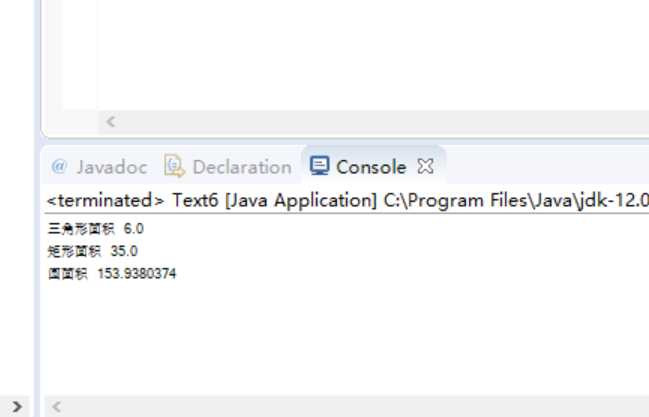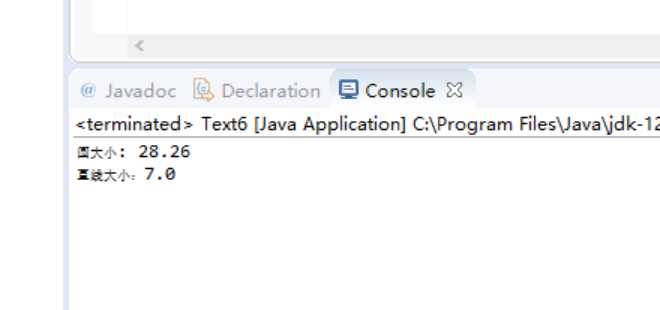标签:str nts 类的使用 具体类 imp ati 避免 面积 对象
实验报告
(一)抽象类的使用
1.设计一个类层次,定义一个抽象类--形状,其中包括有求形状的面积的抽象方法。 继承该抽象类定义三角型、矩形、圆。 分别创建一个三角形、矩形、圆存对象,将各类图形的面积输出。
注:三角形面积s=sqrt(p(p-a)(p-b)*(p-c)) 其中,a,b,c为三条边,p=(a+b+c)/2
2.编程技巧
(1) 抽象类定义的方法在具体类要实现;
(2) 使用抽象类的引用变量可引用子类的对象;
(3) 通过父类引用子类对象,通过该引用访问对象方法时实际用的是子类的方法。可将所有对象存入到父类定义的数组中。
1)实验代码
package text6;
public abstract class Shape {
public void Area() {
System.out.println(this.getArea());
}
public abstract String getArea();
}package text6;
public class Triangle extends Shape {
private double a,b,c;
public Triangle(double a, double b, double c) {
super();
this.a = a;
this.b = b;
this.c = c;
}
public String getArea() {
double p=(a+b+c)/2;
return "三角形面积 "+Math.sqrt(p*(p-a)*(p-b)*(p-c));
}
public double getA() {
return a;
}
public void setA(double a) {
this.a = a;
}
public double getB() {
return b;
}
public void setB(double b) {
this.b = b;
}
public double getC() {
return c;
}
public void setC(double c) {
this.c = c;
}
}package text6;
public class Rectangle extends Shape {
private double length;
private double width;
public double getLength() {
return length;
}
public void setLength(double length) {
this.length = length;
}
public double getWidth() {
return width;
}
public void setWide(double width) {
this.width = width;
}
public Rectangle(double length, double width) {
super();
this.length = length;
this.width = width;
}
public String getArea() {
return "矩形面积 "+this.width*this.length;
}
}
package text6;
public class Circle extends Shape{
private double r;
public Circle(double r) {
super();
this.r = r;
}
public String getArea() {
return "圆面积 "+r*r*3.1415926;
}
}package text6;
public class Text6 {
public static void main(String[] args) {
Shape s1=new Triangle(3,4,5);
Shape s2=new Rectangle(5,7);
Shape s3=new Circle(7);
s1.Area();
s2.Area();
s3.Area();
}
}2)运行截图

二)使用接口技术
1定义接口Shape,其中包括一个方法size(),设计“直线”、“圆”、类实现Shape接口。分别创建一个“直线”、“圆”对象,将各类图形的大小输出。
2.编程技巧
(1) 接口中定义的方法在实现接口的具体类中要重写实现;
(2) 利用接口类型的变量可引用实现该接口的类创建的对象。
1)实验代码
package text6;
public interface Shape {
public void size();
}package text6;
public class Circle implements Shape {
private double r;
public double getR() {
return r;
}
public void setR(double r) {
this.r = r;
}
public Circle(double r) {
super();
this.r = r;
}
public void size() {
System.out.println("圆大小: "+r*r*3.14);
}
}package text6;
public class Line implements Shape {
private double l;
public double getL() {
return l;
}
public Line(double l) {
super();
this.l = l;
}
public void setL(double l) {
this.l = l;
}
public void size() {
System.out.println("直线大小:"+l);
}
}package text6;
public class Text6 {
public static void main(String args[]) {
Shape s1=new Circle(3);
Shape s2=new Line(7);
s1.size();
s2.size();
}
}
课程总结
这周主要是学了抽象类和接口
对象 都通过对象的多态性产生实例化对象 都通过对象的多态性产生实例化对象
局限 抽象类有单继承的局限 接口没有单继承的局限
实际 作为一个模板 是作为一个标准或是表示一种能力
选择 如果抽象类和接口都可以使用的话,优先使用接口,因为避免单继承的局限 如果抽象类和接口都可以使用的话,优先使用接口,因为避免单继承的局限
特殊 一个抽象类中可以包含多个接口,一个接口中可以包含多个抽象类 一个抽象类中可以包含多个接口,一个接口中可以包含多个抽象类
标签:str nts 类的使用 具体类 imp ati 避免 面积 对象
原文地址:https://www.cnblogs.com/zuoshuai/p/11663180.html